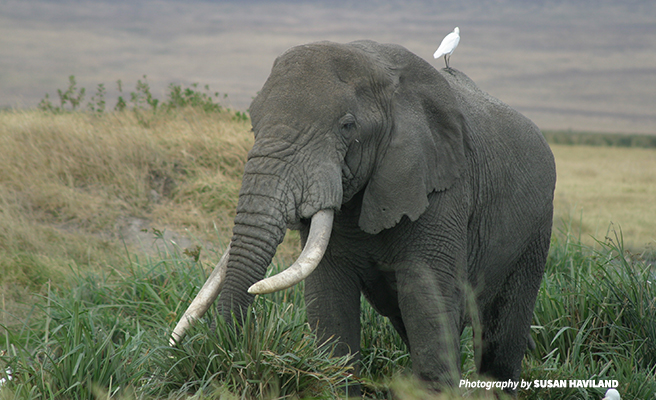ICYMI: The Latest on Africa’s Elephant Poaching Crisis

In mid-February, Ugandan authorities seized more than a ton of ivory in Kampala, adding to the already notable ivory news that kicked off 2017. The past few weeks have continued to bring in more significant news concerning Africa’s elephant poaching crisis. The following is a summary of some of the latest developments:
A giant tusker is killed in Kenya
A 50-year-old bull elephant with giant tusks—known as Satao II—was found dead in southern Kenya’s Tsavo ecosystem in early January. A tourist had apparently spotted Satao II with a fresh wound in late December. Despite closer monitoring, authorities were unable to save him. The cause of death: a poisoned arrow.
Although Satao II’s body was found with his tusks intact, authorities are treating the case as a poaching attempt. Kenya Wildlife Service (KWS) has since apprehended two poachers from a neighboring community.
Satao II was one of only a handful of big tuskers remaining in the Tsavo Conservation Area—an unfortunate reality during a time when these mature bulls are increasingly targeted for their giant tusks. In 2014, two of Kenya’s most revered elephant bulls, Mountain Bull and Satao (after whom Satao II was named), were killed by poachers. Such heavy poaching is already affecting the genetic pool and may even cede to an era where more elephants only have smaller tusks—or no tusks at all.
A ranger is killed in Tsavo ecosystem
While Satao II was killed by poisoned arrows, they are not the only weapons of choice amongst poachers in Tsavo. In early March, KWS rangers on patrol in Tsavo East National Park came into contact with four poachers. The ensuing shootout resulted in the death of two poachers, but two others escaped and later ambushed the rangers elsewhere in the park.
Though rangers eventually shot and killed the remaining poachers, and recovered all weapons, the head of the unit was unfortunately killed in the ambush.
The tragedy is a reminder of the danger faced by those on the ground tasked with protecting Africa’s wildlife.
A notorious elephant poacher goes to jail
In a bit of good news, however, Tanzanian courts recently handed down a 12-year prison sentence to one of the country’s most notorious elephant poachers. Boniface Matthew Maliango is said to have killed thousands of elephants as part of an ivory trafficking network that may have spanned Burundi, Kenya, Mozambique, Tanzania and Zambia.
Maliango reportedly supplied ivory to a Chinese kingpin, Yang Fenglan. Yang, known as “The Ivory Queen,” is currently on trial in Tanzania for trafficking more than 700 elephant tusks off the African continent.
For AWF, the 12-year sentence is a positive indication that courts are increasingly taking wildlife crime seriously. AWF continues to hold, or contribute to, prosecutorial workshops in countries across the continent to sensitize those in law enforcement to the serious nature of wildlife crimes. A regional workshop is in fact taking place this week in South Africa, gathering participants from Botswana, Mozambique, Namibia, South Africa and Swaziland.
Thailand seizes 422 pieces of elephant tusks
Thai authorities in early March seized 422 pieces of elephant tusks hidden in a shipment labeled as unprocessed gemstones. The shipment reportedly came in through Malawi. When a Gambian national came to claim the shipment, authorities arrested and charged him with violating customs and wildlife protection laws.
Thailand was named as one of the “gang of eight” nations that were among the worst in shutting down the ivory trade during the 2013 Conference of Parties of the Convention on International Trade in Endangered Species of Wild Fauna and Flora (CITES), the body that regulates international trade in ivory. (The “gang of eight” included Kenya, Tanzania and Uganda on the supply side; China and Thailand on the consumer side; and Malaysia, Vietnam and the Philippines from a transit-country standpoint.)
Reports in 2016 found that the situation in Thailand appears to be improving, with the amount of ivory openly for sale in Bangkok having dropped over the course of the previous two years. Thai authorities have made a number of large ivory busts in the past few years as well.
EU considers its own ivory ban
The European Union (EU) is considering banning exports of raw ivory starting July 1, according to reports leaked in February. Though the international trade in ivory is already outlawed, EU regulations have allowed for the export of raw and worked ivory tusks obtained before 1990—a loophole that some say criminals have exploited to traffic ivory from recently poached elephants.
It’s positive news, as it closes one loophole that is enabling the illegal ivory trade—but not necessarily enough, from AWF’s viewpoint. “We urge the EU to next work on tightening restrictions around the export of carved ivory,” says Philip Muruthi, vice president for species protection at AWF. “Despite action by many governments to tamp down on ivory trafficking, even the smallest loopholes will continue to be abused by criminal gangs.”
The upshot
Taken together, these incidents show that the fight against elephant poaching and ivory trafficking continues to have significant challenges, but it appears to be progressing in a positive direction. In the meantime, AWF is working across the ivory trafficking supply chain to stop the killing, stop the trafficking and stop the demand of elephant ivory so as to save Africa’s elephants once and for all.